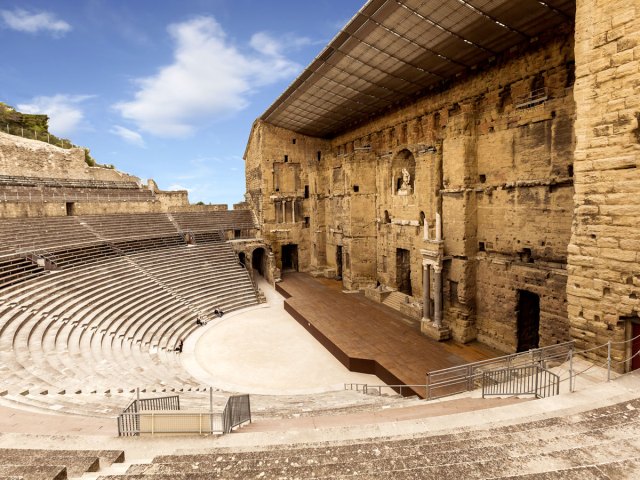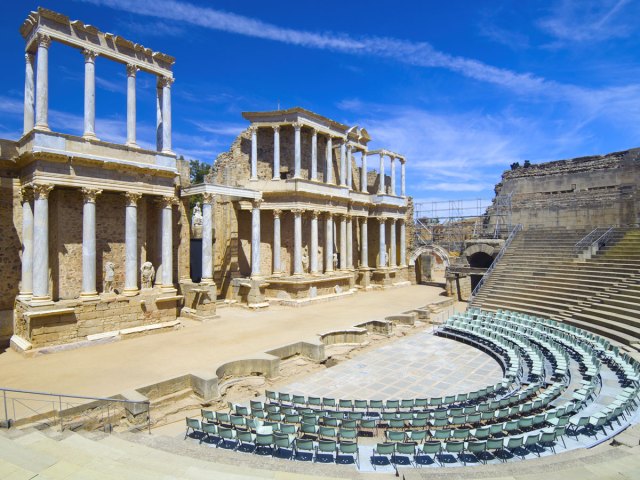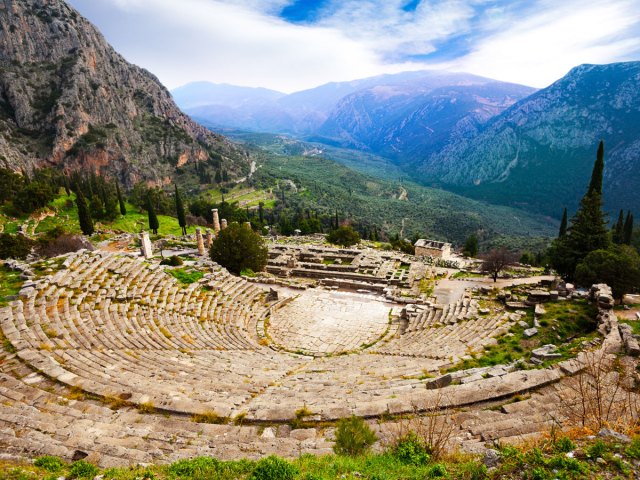Forget popcorn and recliner seats — theaters have come a long way from their earliest days. Stemming from the Greek word theatron, meaning “viewing place,” these outdoor venues hosted thousands of people in ancient times to watch dramatic plays, listen to musical concerts, and laugh at comedy performances. Check out five of the oldest theaters in the world and the fascinating stories behind them.
Roman Theater of Orange – France

Located in France’s Rhône Valley, the Roman Theater of Orange is perhaps one of the best-preserved ancient theaters in the world. Dating back to the early first century CE, the theater was built during the reign of Emperor Augustus, a statue of whom is set in the theater’s facade. Packed with centuries of history, the theater was pillaged in the fifth century BCE, and also served as a refuge during the religious wars that occurred about a thousand years later.
Featuring seats for 10,000 spectators, the UNESCO World Heritage Site was built into the side of a hill surrounding a central orchestra pit that once housed the choir. The theater’s pièce de résistance is its 121-foot-high wall, once lauded by King Louis XIV as the “most beautiful wall in my Kingdom.” Today, the theater still hosts performances to packed crowds, with many events free to the public.
Theater of Mérida – Spain

Constructed in 15 BCE, the Mérida Roman Theater was formerly located in the capital of the Roman province of Lusitania in modern-day Spain. Although the idea of theater was not popular at the time of its construction, the ruling class believed the city required a theater to match its prestige. Thus, Agrippa, the son-in-law of the Emperor, ordered one to be built. The surrounding arena holds a capacity of 6,000 spectators, while the stage is decorated with statues of gods and emperors, including the emperor’s wife, Livia, dressed as the goddess Ceres.
Today, the theater annually hosts the Festival de Mérida, Spain’s oldest classical theater festival. With its ancient walls and outdoor seating still intact, Mérida welcomes talented actors from all over to perform on one of the oldest stages in the world.
Greek Theater of Taormina – Italy

Carved into the side of Mount Tauro during the third century BCE, the Greek Theater of Taormina’s stage today is little more than ruins. Still, its spectacular location on the Sicilian coastline makes it well worth the visit, with views that stretch across the Ionian Sea. The theater once hosted ancient Greek musicals and performances and required 100,000 cubic meters of rock to be excavated from a nearby mountain to build. During the Roman occupation, several columns were added, and the theater transformed into an arena for gladiators with space for 5,400 spectators to watch dramatic scenes unfold.
Once favored by Roman politicians, Taormina continues to thrive as a popular destination for tourists. Thousands of years after it was first built, the theater — having survived earthquakes, wars, and erosion — continues to host seasonal concerts and performances.
Theater of Delphi – Greece

Built into the hillside near the Temple of Apollo, the Theater of Delphi was built in the fourth century BCE out of limestone excavated from Mount Parnassus. It had space to accommodate roughly 5,000 ancient spectators. With 35 descending rows, a circular stage, and space for an orchestra, Delphi was a popular site during ancient festivals, with poets, playwrights, and musicians taking to the stage to entertain the public.
The theater lasted through the Hellenistic and Roman periods and was renovated on more than one occasion — including in 159 BCE by Eumenes II, and later in 67 CE to prepare for a visit from Emperor Nero. Offering picturesque views of the mountainside and olive groves below, the ancient theater remains open to the public and often hosts plays during the summer.
Theater of Dionysus – Greece

Dating back to the sixth century BCE, the Theater of Dionysus in Athens, Greece, is considered the oldest theater in the world. With construction that spanned centuries, the theater likely accommodated up to 17,000 spectators at its height during the fourth century BCE. It featured front-row seats carved into elaborate thrones reserved for the upper echelon of society.
The stage — which depicts scenes from the life of the Greek god of wine, Dionysus — was host to the works of ancient playwrights such as Sophocles, Aristophanes, and Euripides. In addition to the first plays of Athens, musicians, dancers, and mimes would often perform on stage to delighted audiences. Located on the south side of the Acropolis, this outdoor theater no longer hosts performances but remains open to visitors.
More from our network
Daily Passport is part of Inbox Studio, which publishes content that uplifts, informs, and inspires.
















